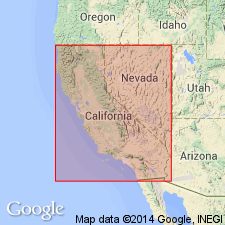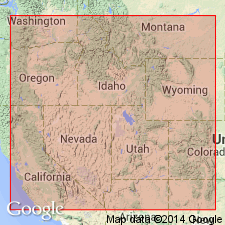
- Usage in publication:
-
- La Porte flora
- Modifications:
-
- [First used]
- Dominant lithology:
-
- Tuff
- AAPG geologic province:
-
- Sierra Nevada province
Summary:
Potbury discussed the La Porte flora but did not use formal term La Porte Tuff.
La Porte flora occurs on west flank of the Sierra Nevada, 15 mi northwest of La Porte, Plumas Co., northern CA. Town of La Porte is near west edge of Downieville quadrangle. One mile north and a little west of town in NE/4 sec. 8, T. 21 N., R. 9 E., in the Upper Dutch Diggings is the tuff bed in which occurs the La Porte flora. The leaf-bearing bed is at top of cliff on west side of the diggings.
Source: US geologic names lexicon (USGS Bull. 1350, p. 414-415).

- Usage in publication:
-
- La Porte leaf-bearing tuff
- Modifications:
-
- Geochronologic dating
- AAPG geologic province:
-
- Sierra Nevada province
Summary:
Pg. 5 (table 1), 14, 15, 16, 20, 22, 24, fig. 12. Report on potassium-argon dating research pertinent to some problems of Cenozoic history of the Sierra Nevada. Plagioclase from La Porte leaf-bearing tuff gives radiometric (K-Ar) age of 32.3 Ma. Lovejoy and Ingalls Formations can be no older than 23.8 Ma and no younger than 22.2 Ma. Therefore, the Lovejoy basalt could not underlie La Porte Tuff [flora] as was believed by Durrell (1959, California Univ. Pubs. Geol. Sci., v. 34).
Sample collected 2,000 ft S. 16 deg. W. from NE corner sec. 8, T. 21 N., R. 9 E., in Upper Dutch Diggings, Downieville quadrangle, northern CA.
Source: US geologic names lexicon (USGS Bull. 1350, p. 414-415).

- Usage in publication:
-
- La Porte Tuff
- La Porte leaf-bearing dacite tuff
- Modifications:
-
- Geochronologic dating
- AAPG geologic province:
-
- Sierra Nevada province
Summary:
Pg. 967 (Potassium-argon K-Ar dates and Tertiary floras of North America). Referred to as La Porte Tuff and La Porte leaf-bearing dacite tuff. Plants in tuff have long been considered to be of Late Eocene age (Potbury, 1937, MacGinitie, 1941). This was one of prime pieces of evidences for "Eocene auriferous gravels" in the Sierra Nevada. Age according to K-Ar date: late Chadronian (Oligocene).
Source: US geologic names lexicon (USGS Bull. 1350, p. 414-415).
For more information, please contact Nancy Stamm, Geologic Names Committee Secretary.
Asterisk (*) indicates published by U.S. Geological Survey authors.
"No current usage" (†) implies that a name has been abandoned or has fallen into disuse. Former usage and, if known, replacement name given in parentheses ( ).
Slash (/) indicates name conflicts with nomenclatural guidelines (CSN, 1933; ACSN, 1961, 1970; NACSN, 1983, 2005, 2021). May be explained within brackets ([ ]).

